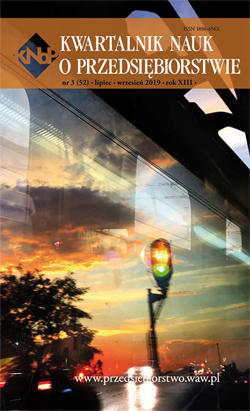Abstrakt
Celem artykułu jest pokazanie blockchain jako nowego i potencjalnie potężnego mechanizmu koordynacji, uwzględniającego możliwości i wymagania systemów produkcyjnych Przemysłu 4.0. Od 2017 r. technologia blockchain przyciąga coraz większą uwagę naukowców i praktyków gospodarczych. Jednak nadal kojarzona jest głównie z rynkiem kryptowalut, co powoduje, że jej potencjał w zakresie zarządzania i organizacji przedsiębiorstw nie jest wykorzystany.
Full Text
Bibliografia
Adner, R. (2017). Ecosystem as structure: An actionable construct for strategy. Journal of Management, 43(1), 39–58.
Arthur, W. (2017). Where is technology taking the economy? McKinsey Quarterly, October, https://www.mckinsey.com/business-functions/mckinsey-analytics/our-insights/where-is-technologytaking-the-economy (retrieved 02.02.2019).
Baheti, R., Gill, H. (2011). Cyber-physical Systems. [in:] T. Samad and A.M. Annaswamy (eds.), The impact of Control Technology, pp. 161-166.
Blau, P., Scott, W. (1962). Formal organizations. Scott, Foresman, San Francisco.
Bughin, J, Catlin, T, Hirt, M and Willmott, P. (2018). Why digital strategies fail. https://www.mckinsey.com/business-functions/digital-mckinsey/our-insights/why-digital-strategies-fail (retrieved 11.01.2019).
Crowston, K. (1994). A Taxonomy of Organisational Dependencies and Coordination Mechanisms. MIT Center for Coordination Science Working Paper. Massachusetts Institute of Technology.
Danaher, J., Hogan M., Noone, C., Kennedy, R., Behan A., De Paor A., Felzmann H., Haklay M., Khoo S., Morison J., Murphy, M., O’Brolchain N., Schafer B., Shankar K. (2017). Algorithmic governance: Developing research agenda through the power of collective intelligence. Big Data & Society, 4(2), 1-21.
Davidson, S., De Filippi, P. and Potts, J. (2016). Economics of Blockchain. http://dx.doi.org/10.2139/ssrn.2744751
Desmet, D, Maerkedahl, N, Shi, P. (2017). Adopting an ecosystem view of business technology. https://www.mckinsey.com/business-functions/digital-mckinsey/our-insights/adopting-anecosystem-view-of-business-technology (retrieved 12.01.2019).
https://dictionary.cambridge.org/dictionary/english/coordination.
Espinosa, J, Lerch, F, Kraut, R. (2004). Explicit versus implicit coordination mechanisms and task dependencies: One size does not fit all. In: E. Salas, S. Fiore (eds.), Team cognition: Understanding the factors that drive process and performance, Washington, DC: American Psychological Association, pp. 107-129.
Frances, J, Levacić, R, Mitchell J., Thompson G. (1991). Introduction. In: G. Thompson, J. Frances, R. Levacić, J. Mitchell (eds.). Markets, Hierarchies & Networks: The Coordination of Social Life, London, Thousand Oaks, New Delhi: Sage Publications.
Fugate, B, Sahin F, Mentzer J. (2006). Supply Chain Management Coordination Mechanisms, Journal of Business Logistics, 27(2), pp. 129-161.
Grasso, A. (2018). Smart Contracts: The Business Process Enablers for Blockchain, https://medium.com/@antgrasso/smart-contracts-the-business-process-enablers-for-blockchain-10200b5143db (retrieved 2.01.2019).
Hassan, S., De Filippi, P. (2017). The Expansion of Algorithmic Governance: From Code is Law to Law is Code, Field Actions Science Reports, 17, pp. 88-90.
Jacobson, R. (2013). 2.5 quintillion bytes of data created every day. How does CPG & retail manage it?, April 24, 2013, IBM Consumer Products Industry Blog, https://www.ibm.com/blogs/insightson-business/consumer-products/2-5-quintillion-bytes-of-data-created-every-day-how-does-cpgretail-manage-it/ (retrieved 12.01.2019).
Kagermann, H, Wahlster W, Helbig J. (2013). Recommendations for Implementing the Strategic Initiative Industrie 4.0. Industrie 4.0 Working Group of Acatech., Berlin.
Kaldor, N. (1934). The Equilibrium of the Firm, The Economic Journal, March, pp. 60-76.
Lavazova O,, Dehling T., Sunyaev A. (2019). From Hype to Reality: A Taxonomy of Blockchain Applications, Proceedings of the 52nd Hawaii International Conference on System Sciences (HICSS 2019), January 8-11, 2019, Wailea, Maui, HI, USA, forthcoming.
Lee, J., Bagheri, B., Kao, H. (2015). A Cyber-Physical Systems architecture for Industry 4.0-based manufacturing systems. Manufacturing Letters, 3, pp. 18-23.
Liao, Y., Deschamps F., Lourdes E., Ramos, L. (2017). Past, present and future of Industry 4.0 – a systematic literature review and research agenda proposal, International Journal of Production Research, 55(12), 3609-3629. http://dx.doi.org/10.1080/00207543.2017.1308576
McKinsey (2016). Industry 4.0: How to navigate digitization of the manufacturing system. McKinsey & Company.
Malone, T., Crowston, K. (1990). What is Coordination Theory and How Can It Help Design Cooperative Work Systems. Proceedings of the Conference on Computer Supported Cooperative Work, Los Angeles, CA.
Malone, T., Crowston, K. (2012). The Interdisciplinary Study of Coordination. In: G. Olson, T. Malone, J. Smith (eds.) Coordination Theory and Collaboration Technology, New York and Hove: Psychology Press. pp. 7-50.
Malone, T, Yates, J., Benjamin, R. (1987). Electronic Markets and Electronic Hierarchies, Communications of the ACM, 30(6), pp. 484-497.
March, J, Simon, H. (1958). Organizations. New York: Wiley.
Mintzberg, H. (1979). The Structuring of Organizations., Englewood Cliffs, NJ: Prentice-Hall.
Pietrewicz, L. (2019a). Blockchain: A coordination mechanism, ENTRENOVA Conference Book of Proceedings, forthcoming.
Pietrewicz, L. (2019b). Coordination in the age if Industry 4.0, Economic and Social Development: Book of Proceedings, Varazdin: Varazdin Development and Entrepreneurship Agency, pp. 264-274.
Poovendran, R. (2010). Cyber-Physical Systems: Close Encounters Between Two Parallel Worlds. Proceedings of the IEEE, 98(8), pp. 1363-1366.
Reeves, M., Ueda, D., Chittaro, C. (2017), Getting physical: The rise of hybrid ecosystems. The Boston Consulting Group Henderson Institute.
Schepker, D., Oh W.-Y., Martynov A., Poppo L. (2014), The Many Futures of Contracts: Moving Beyond Structure and Safeguarding to Coordination and Adaptation, Journal of Management, Vol. 40 No. 1, pp. 193-225.
Schwab, K. (2016). The Fourth Industrial Revolution. Geneva: World Economic Forum
Srivastava, M., Bradshaw (2019). Israeli group’s spyware ‘offers keys to Big Tech’s cloud’, https://www.ft.com/content/95b91412-a946-11e9-b6ee-3cdf3174eb89 (retrieved 19.07.2019).
The Economist (2015). The trust machine. The promise of the blockchain. https://www.economist.com/leaders/2015/10/31/the-trust-machine (retrieved 12.01.2019).
Thompson, J. (1967). Organizations in Action: Social Science Bases of Administrative Theory, New York: McGraw-Hill.
Van de Ven, A., Delbecq, A, Koenig, R. (1976). Determinants of Coordination Modes within Organizations. American Sociological. Review 41(2), pp. 322-338.
Zmudzinski, A. (2019). Tether USDT Is Launching on a ‘Pure PoS’ Blockchain, Algorand, https://cointelegraph.com/news/tether-usdt-is-launching-on-a-pure-pos-blockchain-algorand (retrieved 21.07.2019).
Autor
Autor (Autorzy) artykułu oświadcza, że przesłane opracowanie nie narusza praw autorskich osób trzecich. Wyraża zgodę na poddanie artykułu procedurze recenzji oraz dokonanie zmian redakcyjnych. Przenosi nieodpłatnie na Oficynę Wydawniczą SGH autorskie prawa majątkowe do utworu na polach eksploatacji wymienionych w art. 50 Ustawy z dnia 4 lutego 1994 r. o prawie autorskim i prawach pokrewnych – pod warunkiem, że praca została zaakceptowana do publikacji i opublikowana.
Oficyna Wydawnicza SGH posiada autorskie prawa majątkowe do wszystkich treści czasopisma. Zamieszczenie tekstu artykuły w repozytorium, na stronie domowej autora lub na innej stronie jest dozwolone o ile nie wiąże się z pozyskiwaniem korzyści majątkowych, a tekst wyposażony będzie w informacje źródłowe (w tym również tytuł, rok, numer i adres internetowy czasopisma).
Osoby zainteresowane komercyjnym wykorzystaniem zawartości czasopisma proszone są o kontakt z Redakcją.

